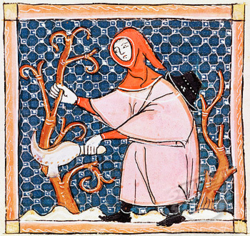Edge Tool Making 2
Edge tool making was one of the most important trades, as the makers made all the cutting tools used by other craftsmen - they often also made weapons when required, although generally the armourers and swordsmiths, like the cutlers, were separate crafts, and controlled by separate guilds. However the methods used were similar, as were the materials and the tools, and by the 19th century the industrial factories of the Midlands in the UK were making a wide range of products from cutlery to heavy edge tools. Looking at the Sheffield lists from the 19th century, one also sees that some edge tool makers were also makers of Sheffield plate, saw makers or even steel producers. In 1833 there were 59 edge tool registered in Sheffield. By 1860 this figure had increased to 78 only to decline by 1888 to 68. However the actual number was likely to have been higher as scythe makers and others who also made edge tools were registered seperately.
In the villages the edge tool maker was often the village blacksmith, who provided and often repaired all the iron and steel objects required for village life. It was not until the arrival of the petrol engine in the early 20th century that the village smithies started to close as horse-power replaced the power of the horse. Some town and village smiths became specialist edge tool makers, and continued in business despite the competition from the industrial makers. There is thus a 2000 year history of edge tool making in Europe, that remained virtually unbroken - and even today there can be found a few specialist edge tool makers working in the traditional way (mainly in the UK, the USA and France).
Trade directories, parish records, censuses and year books are all good sources to research the history of edge tool making. Large industrial concerns such as Brades, Elwell, Nash or Spear & Jackson are still well known, as are the names of some of the smaller firms who have long since disappeared such as Fussells, Skinner & Johnson or S&J Kitchin. Less is known of the hundreds of small rural makers that survived into the 20th century such as Knapman, Loder, Buckland or Finch Bros who employed a number of workers, and even less of the one or two man businesses such as Steed Bros, Fenner, Joiner or Padfield.
The methods of manufacture had remained little changed until the 18th century, which saw the birth of the Industrial Revolution. One-off production was gradually replaced by batch production, and later by mass production. One man could produce only a few tools per day by hand, but with a water powered trip hammer and batch production, i.e. just one part of the process being undertaken at any time, the output could rise to several dozen. With modern techniques such as roller forging, the output could be several hundred - yet despite the availability of low cost factory produced blades, in some regions the small village maker survived well into the 20th century.
The reasons for this survival are not simple ones, as many factors must be considered: e.g. transport, availablity of raw materials, the requirement for skilled labour and brand loyalty. Even today the large manufacturers such as Spear & Jackson use a wide range of trade names such as Harrison, Fussell, Nash or WHS (W Hunt & Sons) especially on tools for export or specific trades, as the end-users will still remain loyal to a known make or brand. It is thus likely small makers survived only as long as they retained a local market.

